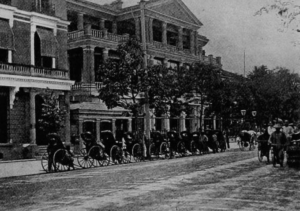In 1892, Lafcadio Hearn published an article in the Atlantic Monthly on the unique characteristics of Japanese gardens. Hearn was a writer and teacher, born in Greece and raised in Ireland, who traveled to Japan in 1890 and remained there for the rest of his life.1 His article gives a general background on the appearance, history, and symbolism of Japanese gardens for his western readers through a description of his own garden, and ends with the gloomy prediction that “…the old katchiû-yashiki and its gardens – will doubtless have vanished forever before many years… For impermanency is the nature of all, more particularly in Japan, and the changes and the changers shall also be changed until there is found no place for them, and regret is vanity.”2 Contrary to his prediction, by 2006 there would be at least 432 Japanese gardens throughout the world.3 Rather than disappearing from Japan, their global popularity seems to reflect a common fear of the very impermanence that Hearn believed would lead to their disappearance. As spaces, Japanese gardens symbolize the preservation of natural landscapes whose value seems increasingly important as urban centers grow and natural areas diminish.
Henri Lefebvre proposes that as natural spaces disappear, they do not vanish completely. Natural space becomes “…the background of the picture; as decor, and more than decor, it persists everywhere, and every natural detail, every natural object is valued even more as it takes on symbolic weight (the most insignificant animal, trees, grass, and so on).”4 This symbolic weight is clearly identified by Hearn, whose account of his own garden is given primarily through descriptions of the symbolic meaning of the rocks, plants, and animals which inhabit it. He describes objects and creatures both physically and through the myths, legends, and traditions which surround them and signify their role in the garden. Not only do they carry individual symbolic meaning, but the garden as a whole is “…at once a picture and a poem; perhaps even more a poem than a picture. For as nature’s scenery, in its varying aspects, affects us with sensations of joy or of solemnity, of grimness or of sweetness, of force or of peace, so must the true reflection of it in the labor of the landscape gardener create not merely an impression of beauty, but a mood in the soul.”5
This symbolism or “mood in the soul” acquires a new meaning in light of the western adoption and re-creation of Japanese gardens. Questions arise as to whether the gardens symbolize something inherently Japanese and are therefore only authentic when they are created in Japan according to strict traditions, or whether they symbolize a broader appreciation of nature which can be replicated anywhere in the world. Hearn argues that “In the foreigner,” the aesthetic complexities of the representation of nature in Japanese gardens, “needs to be cultivated by study. It is inborn in the Japanese; the soul of the race comprehends Nature infinitely better than we do, at least in her visible forms.”5 His suggestion that non-Japanese people cannot comprehend the full meaning and complexity of this art form is reflected by modern Japanese scholars such as Sato and Kajinishi who argue that Japanese gardens in the West are merely inauthentic reproductions (“Japanese-style gardens”), rather than the real thing.6 This idea is taken even further by the notion that Japanese gardens in the late 19th century, lost their authenticity because the Japanese government, being partially controlled by western powers through treaties, recast them embodiments of Japanese nationalism.7
While questions of authenticity, in Western and Japanese gardens, are highly contested among historians and specialists, the spatial concept of a garden which serves to “…copy faithfully the attractions of a veritable landscape, and to convey the real impression that a real landscape communicates” is one that captured the imagination of the world.5 A place which is designed not only to reflect vanishing natural space, but also to express “moral lessons” and “abstract ideas” through its design is something which can be universally appreciated.8 While the original creator of Hearn’s garden was long gone by the time he owned it and whatever lesson or idea it was meant impart had been forgotten, Hearn believed that, “…as a poem of nature it requires no interpreter.”8 The gardens that exist today, whether ancient or modern, Japanese or Western, built on the practices of artistic tradition or ideologies of nationalism, are, as Christian Tagsold points out, “real places.”9 Their histories, symbolic meaning, and authenticity vary, but as places, they are created with intent. They are spaces “confiscated from nature” and turned into conscious representations of a particular kind of space.10 Like the natural spaces they reflect, there is an impermanence in the meaning and understanding of Japanese gardens. Although they are created according to certain principles and meant to represent specific ideas, (moral lessons, nationalist ideology, or western imitations of Japanese spaces) their meaning is constantly changing.
- Elizabeth Bisland, The Life and Letters of Lafcadio Hearn, Volume 1 (Boston and New York: Houghton Mifflin Company, 1906). [↩]
- Lafcadio Hearn, “In a Japanese Garden,” Atlantic Monthly, July 1892, Volume 70, Issue 417, https://www.trussel.com/hearn/jgarden.htm#Part1. [↩]
- Christian Tagsold, Spaces in Translation: Japanese Gardens and the West (Philadelphia: University of Pennsylvania Press, 2017), 2, ProQuest Ebook Central. [↩]
- Henri Lefebvre, The Production of Space, trans. Donald Nicholson-Smith (Oxford: Basil Blackwell Ltd, 1991), 30. [↩]
- Hearn, “In a Japanese Garden.” [↩] [↩] [↩]
- Tagsold, Spaces in Translation, 79. [↩]
- Ibid., 84. [↩]
- Ibid. [↩] [↩]
- Tagsold, Spaces in Translation, 84. [↩]
- Lefebvre, The Production of Space, 49. [↩]
